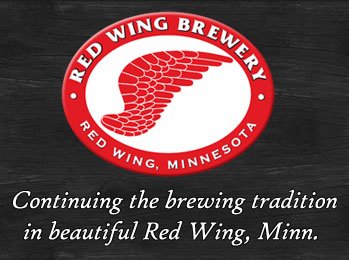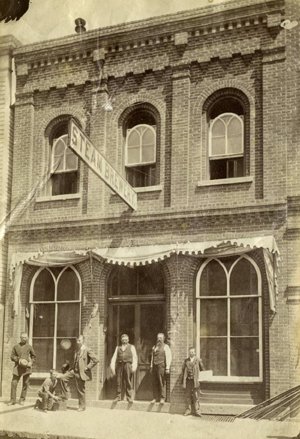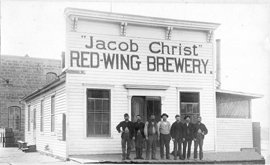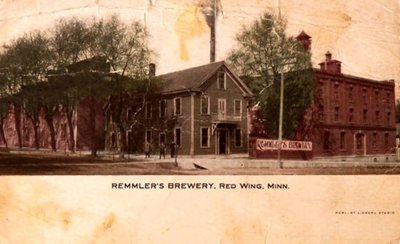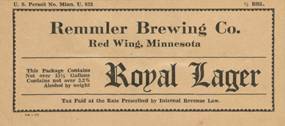The state of Minnesota is situated in what has long been known as America’s “Grain Belt,” and the City of Red Wing, located on the Mississippi River, has historically been one of the thriving ports used to ship Minnesota grain to other markets. As one of the historical markers in Red Wing’s Bay Point Park states, “Fertile fields within and beyond Red Wing yielded abundant harvests, supplying grain for grist and flour mills and later for the malting companies and breweries.”
It was natural, then, that brewing would evolve as one of the earliest industries of Red Wing. In fact, by 1867, the city once boasted a total of five breweries: John Hartman’s Hay Creek Brewery (on the west end of Featherstone Road), John Melander’s National Brewery (on the north side of Main Street, east of Jefferson), Lorenz Hoffman’s Steam Brewery (223 Bush Street [the only existing building in Red Wing that once served as a brewery]), Phillip Hoffman’s Brewery (1610-1636 W. Main Street), and William Heising’s City Brewery (405 W. 5th Street). Of these, Phillip Hoffman’s and William Heising’s breweries were the two that went on to take a place of prominence in Red Wing until Prohibition.
Phillip Hoffman pioneered the brewing industry in Red Wing in 1857. When he died in 1868, his widow, Christina, took over operations until she married Jacob Christ, a respected local saloon keeper. The brewery was renamed the “Jacob Christ Red Wing Brewery” in 1872, and a large stone building was erected to accommodate the need for expansion. Jacob passed away in 1890, and Christina sold the business to the new Red Wing Brewing Company in 1893. Eleven years later, in 1904, Zimmermann and Featherston bought the brewery, although the name was changed back to the Red Wing Brewing Co. in 1909 and operated as such until Prohibition in 1919. While the company survived the Prohibition era as the Red Wing Products Co. (producing goods such as non-alcoholic malt beverages, ice, vinegar and cider), outdated equipment led to the brewery’s demise by 1937, and its buildings along what is now Old West Main Street were eventually razed. A small white building and an industrial garage now stand on the site.
While Hoffman’s brewery was the first in Red Wing, William Heising’s brewery held out to be the last. The business began in 1861 in the Old Minnesota House (which became the brewery’s offices and saloon) on the corner of Bush and 5th Streets. A new three-story brewhouse was added in 1869; it was described by the Red Wing Argus newspaper as “a model for permanent structures. Its firm foundation and thick walls ensure its standing for a century.” Heising ran the brewery until his passing in 1873, but his wife, Christina, continued to expand operations (including the building of a new ice house) until she hired Adolph Remmler in 1875 to manage the company.
Christina and Adolph wed in 1877, and Heising’s brewery was changed to Remmler’s Brewery. To compete with the larger St. Paul breweries, Remmler began to bottle and export his beer to markets as far away as Minneapolis and Ellsworth, Wisconsin. Although Adolph Remmler died in 1908, his son, Otto, took over the company. During Prohobition, Remmler’s did not produce any other products, but Otto maintained the facilities until the company’s re-opening in 1934. The investment in new equipment after Prohibition proved to be too much of a financial burden for the company, and the brewery was sold to the Goodhue County Brewing Company in 1948. Even they could not turn a profit, however, and the brewery closed permanently in 1951. In 1955, the site was leveled, and a supermarket was built at the location of the brewhouse.
Today, the parking lot of Koplin’s Supermarket is located where the Old Minnesota House once stood, and an office complex occupies the ground that used to be the icehouse. While the old brewery’s buildings no longer remain, the Red Wing Republican Eagle reported in 1955 that the old catacomb basement of the brewhouse was solid enough to be sealed up and used for the foundation of the supermarket.
(Our logo and label designs are based on the “red wing” and lithography that were used by the original Red Wing breweries.)
Special thanks to author Doug Hoverson and his book, Land of Amber Waters: The History of Brewing in Minnesota, to Bob Kay and his book, US Beer Labels, Vol. 3 – Central States, and to the Goodhue County Historical Society for serving as invaluable resources for the information and images above.
